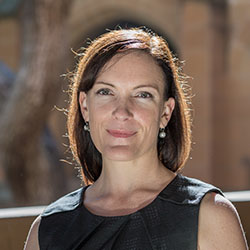Filling the Service Gaps That People Keep Falling Through

Through the health justice partnership at this Sydney hospital, a community lawyer presents to the social work department on the legal problems facing their patients.
5 September 2017 at 8:41 am
Health justice partnerships (HJPs) are demonstrating the difference that services working in partnership can make for the communities who need them, writes Dr Tessa Boyd-Caine, CEO of Health Justice Australia, as the national centre for HJPs celebrates its first anniversary.
Across Australia, 8.5 million people experience three or more legal needs in a given year – and half of these people won’t seek support.
Many of them are some of the most vulnerable and marginalised in our community – making them hard to reach. And they are far more likely to raise their legal needs with a trusted health professional like a GP, community nurse or social worker, than with a lawyer.
That’s why, health and legal organisations have been building collaborations called health justice partnerships to improve their responsiveness and effectiveness in meeting health and legal needs in Australia.
Adding a lawyer to the healthcare team means that healthcare professionals are more able to spot a legal problem and have someone nearby who can solve it. And because legal problems can affect health, it means patients get better, more holistic healthcare too.
In Australia the establishment of health justice partnerships is relatively new but their impact is already being felt by people using health services. Here are some examples.
Mary is an aged pensioner. She suffered from diabetes and had limited mobility. An occupational therapist visited her at home and requested her public housing landlord install a handrail so Mary could keep living independently. Four months later, and still waiting for her handrail, Mary was admitted to hospital after falling on her stairs.
Quang was having trouble focusing on his rehabilitation after a stroke. All he could think about was the guardianship order he had been placed under – the stress of which he blamed for causing his stroke.
Uma was pregnant with her third child but was worried she and her children weren’t safe, as the only time her increasingly violent partner let her leave home was to attend antenatal classes at the local hospital.
Diabetes, rehabilitation after a major health scare or pregnancy are all typical reasons to go to a health service. But the underlying problems in Mary, Quang and Uma’s lives – landlords not meeting their obligations for minor modifications, navigating the guardianship system and family violence – were not problems that health services could resolve alone.
People are far more likely to talk about legal problems like these with their health worker than to seek out a lawyer. Yet health workers may have no experience in navigating tenancy law, guardianship or family violence.
Lawyers and health professionals working together in health justice partnerships were able to identify and respond to legal problems being experienced by Mary, Quang and Uma.
Health justice lawyers are able to see people in hospital wards and community health services. They are considered members of health care teams. They provide legal education at conferences for health professional. By building the capability of health workers to identify and respond to legal needs among their patients, health justice partnerships stop legal problems becoming health problems.
Health Justice Australia was established as the national centre for health justice partnerships. Now as we prepare to hold our first national conference on health justice partnerships we’re working to demonstrate how working in partnership can fill the gaps through which people experiencing disadvantage continually fall.
Siloed health and human services are a familiar story to anyone working in the community sector – even more to the millions of people trying to navigate those services for themselves or the people they care for.
The recent report by the Victorian Royal Commission into Family Violence is only the latest effort to highlight the devastating impact of gaps created by health and human services; and the critical importance of filling those gaps to better meet people’s needs.
With health justice partnerships we are working to demonstrate the difference that services working in partnership make for the communities who need them. By working together we can help stop people at risk of disadvantage becoming truly vulnerable.
About the author: Dr Tessa Boyd-Caine is CEO of Health Justice Australia, the national centre for health justice partnerships. In 2014 Tessa received a Fulbright Professional Scholarship in Non-profit Leadership, supported by Origin Foundation and Australian Scholarships Foundation. She has worked in health, criminal justice and human rights organisations in Australia and internationally and was previously deputy CEO of the Australian Council of Social Service. She tweets at @tboydcaine.
Health Justice Australia is recruiting for a Partnerships Director and a Research Director! Check out the listings in Pro Bono Jobs








